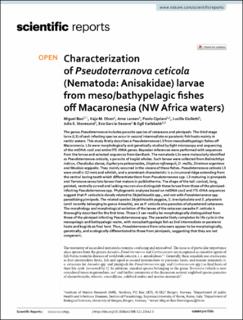| dc.contributor.author | Bao, Miguel | |
| dc.contributor.author | Olsen, Kaja M. | |
| dc.contributor.author | Levsen, Arne | |
| dc.contributor.author | Cipriani, Paolo | |
| dc.contributor.author | Giulietti, Lucilla | |
| dc.contributor.author | Storesund, Julia Endresen | |
| dc.contributor.author | García-Seoane, Eva | |
| dc.contributor.author | Karlsbakk, Egil Erlingsson | |
| dc.date.accessioned | 2023-02-03T13:35:17Z | |
| dc.date.available | 2023-02-03T13:35:17Z | |
| dc.date.created | 2022-11-12T13:24:13Z | |
| dc.date.issued | 2022 | |
| dc.identifier.issn | 2045-2322 | |
| dc.identifier.uri | https://hdl.handle.net/11250/3048350 | |
| dc.description.abstract | The genus Pseudoterranova includes parasite species of cetaceans and pinnipeds. The third stage larva (L3) of seal-infecting species occur in second intermediate or paratenic fish hosts mainly in neritic waters. This study firstly describes a Pseudoterranova L3 from meso/bathypelagic fishes off Macaronesia. L3s were morphologically and genetically studied by light microscopy and sequencing of the mtDNA cox2 and entire ITS rDNA genes. Bayesian inferences were performed with sequences from the larvae and selected sequences from GenBank. The nematode L3s were molecularly identified as Pseudoterranova ceticola, a parasite of kogiid whales. Such larvae were collected from Bolinichthys indicus, Chauliodus danae, Eupharynx pelecanoides, Diaphus rafinesquii, D. mollis, Diretmus argenteus and Maulisia argipalla. They mainly occurred in the viscera of these fishes. Pseudoterranova ceticola L3 were small (< 12 mm) and whitish, and a prominent characteristic is a circumoral ridge extending from the ventral boring tooth which differentiate them from Pseudoterranova spp. L3 maturing in pinnipeds and Terranova sensu lato larvae that mature in poikilotherms. The shape of the tail: conical, long, pointed, ventrally curved and lacking mucron also distinguish these larvae from those of the pinniped-infecting Pseudoterranova spp. Phylogenetic analyses based on mtDNA cox2 and ITS rDNA sequences suggest that P. ceticola is closely related to Skrjabinisakis spp., and not with Pseudoterranova spp. parasitizing pinnipeds. The related species Skrjabinisakis paggiae, S. brevispiculata and S. physeteris (until recently belonging to genus Anisakis), are as P. ceticola also parasites of physeteroid cetaceans. The morphology and morphological variation of the larvae of the cetacean parasite P. ceticola is thoroughly described for the first time. These L3 can readily be morphologically distinguished from those of the pinniped-infecting Pseudoterranova spp. The parasite likely completes its life cycle in the mesopelagic and bathypelagic realm, with meso/bathypelagic fish as 2nd intermediate or paratenic hosts and kogiids as final host. Thus, Pseudoterranova from cetaceans appear to be morphologically, genetically, and ecologically differentiated to those from pinnipeds, suggesting that they are not congeneric. | en_US |
| dc.language.iso | eng | en_US |
| dc.publisher | Nature | en_US |
| dc.rights | Navngivelse 4.0 Internasjonal | * |
| dc.rights.uri | http://creativecommons.org/licenses/by/4.0/deed.no | * |
| dc.title | Characterization of Pseudoterranova ceticola (Nematoda: Anisakidae) larvae from meso/bathypelagic fishes off Macaronesia (NW Africa waters) | en_US |
| dc.type | Journal article | en_US |
| dc.type | Peer reviewed | en_US |
| dc.description.version | publishedVersion | en_US |
| dc.rights.holder | Copyright 2022 The Author(s) | en_US |
| dc.source.articlenumber | 17695 | en_US |
| cristin.ispublished | true | |
| cristin.fulltext | original | |
| cristin.qualitycode | 1 | |
| dc.identifier.doi | 10.1038/s41598-022-22542-0 | |
| dc.identifier.cristin | 2072803 | |
| dc.source.journal | Scientific Reports | en_US |
| dc.identifier.citation | Scientific Reports. 2022, 12, 17695. | en_US |
| dc.source.volume | 12 | en_US |
| dc.source.issue | 1 | en_US |

